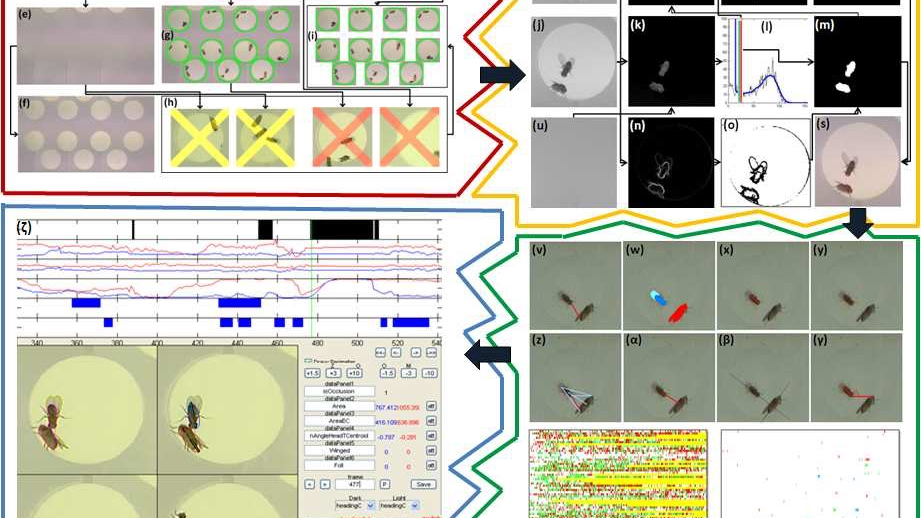Video Tracking for Behavioral Identification in Neuroscience-
Drosophila.

Overview
Client: Research Institute of Molecular Pathology
Project: Video Tracking for Behavioral Identification in Drosophila
Industry: Neuroscience Research
Technologies Used: Advanced Algorithms, Machine Learning, High-Performance Computing, Dynamic
Programming, Pattern Recognition Software
1. Background
Understanding how genes, neural circuits, and behavior are interconnected is a fundamental challenge in neuroscience. The fruit fly, Drosophila melanogaster, is a key model organism thanks to its well-mapped genetics and innate behaviors like courtship rituals.
Traditionally, analyzing Drosophila behavior involved manually scoring video recordings—a tedious and time-consuming process prone to human error. This bottleneck hindered large-scale genetic studies and slowed the discovery of new biological insights.
2. Objectives
- Develop a Fully Automated Tracking System: Create software capable of analyzing behavior videos of Drosophila without human intervention.
- Accurately Resolve Occlusions: Design algorithms to reliably identify individual flies even when they overlap or occlude each other during interactions.
- Enhance Data Quality Beyond Human Capabilities: Achieve a level of precision and robustness in behavioral scoring that surpasses manual methods.
- Implement Advanced Pattern Recognition and Machine Learning: Use sophisticated algorithms to detect both known and novel behavioral patterns, improving over time through machine learning.
- Integrate with Existing Systems: Ensure seamless integration with high-performance computing clusters and existing data platforms for efficient processing.
3. Solution
To meet these goals, we developed an innovative software solution with several key components:
1. Preprocessing and Quality Control
- Video Quality Assurance: The software preprocesses videos to correct lighting issues, remove unsuitable footage, and ensure they meet the necessary standards for accurate analysis.
- Automated Arena Detection: It identifies individual arenas within multi-chamber videos, allowing parallel processing of multiple fly interactions.
2. Advanced Tracking and Occlusion Resolution
- Dynamic Programming Algorithms: We created a two-fly tracker that solves occlusions by modeling identity assignments as an optimization problem, achieving over 99% accuracy.
- Reliable Identity Assignment: The system uses both local and global information to maintain accurate tracking of each fly throughout the video, even in complex scenarios.
3. Pattern Recognition and Machine Learning
- Behavioral Event Detection: The software converts video data into detailed time series, detecting both established and new behavioral patterns using statistical methods.
- Customizable Classifiers: Researchers can define and train classifiers for specific behaviors, enabling tailored analyses.
4. Integration and Scalability
- High-Performance Computing Integration: The solution works seamlessly with existing computing clusters, allowing efficient processing of large volumes of data.
- User-Friendly Interface: A web interface enables bulk submission of videos and management of tracking results, making it easy for researchers to use.
4. Challenges
- Achieving High Accuracy: We needed to reach a level of accuracy in fly identification and behavior scoring that exceeded human capabilities.
- Solving the Occlusion Problem: Developing algorithms that could reliably track individual flies even when they overlapped was a significant technical hurdle.
- Handling Complex Video Data: The software had to process videos with varying quality and environmental conditions, including complex fly interactions.
- Ensuring User Adoption: It was important to create a system that was not only powerful but also easy to understand and use, to encourage acceptance by researchers.
- Scalability and Integration: Integrating the new software with existing high-performance computing resources without disrupting ongoing research was essential.
5. Results
- Massive Time Savings: The system processed the equivalent of over 100 years of manual scoring work in just the first week.
- Exceptional Accuracy: Achieved 99.99% accuracy in identifying individual flies, with an error rate of less than 0.5 seconds per hour of video.
- Superior Behavioral Analysis: Provided behavioral scores that were more robust and accurate than those obtained through manual scoring.
- Enabled New Research Opportunities: Opened the door for large-scale experiments and new biological insights that were previously unattainable due to the limitations of manual methods.
6. Lessons Learned
- Modular Architecture Enhances Flexibility: Separating the system into clear layers improved flexibility and reduced errors during updates or changes.
- Automation Improves Quality and Efficiency: Automating the analysis not only saved time but also significantly improved data accuracy and consistency.
- User-Friendly Design is Crucial: An intuitive interface and understandable scoring methods were key to gaining acceptance from the research community.
- Performance Tuning is Essential for Scalability: Addressing scalability challenges required careful performance optimization before deployment.
7. Conclusion
By partnering with us, you're gaining a team with proven expertise in delivering innovative, scalable systems that make a significant impact in neuroscience research. Our experience in handling complex, mission-critical projects translates directly to industries where data analysis, automation, and precision are vital.

